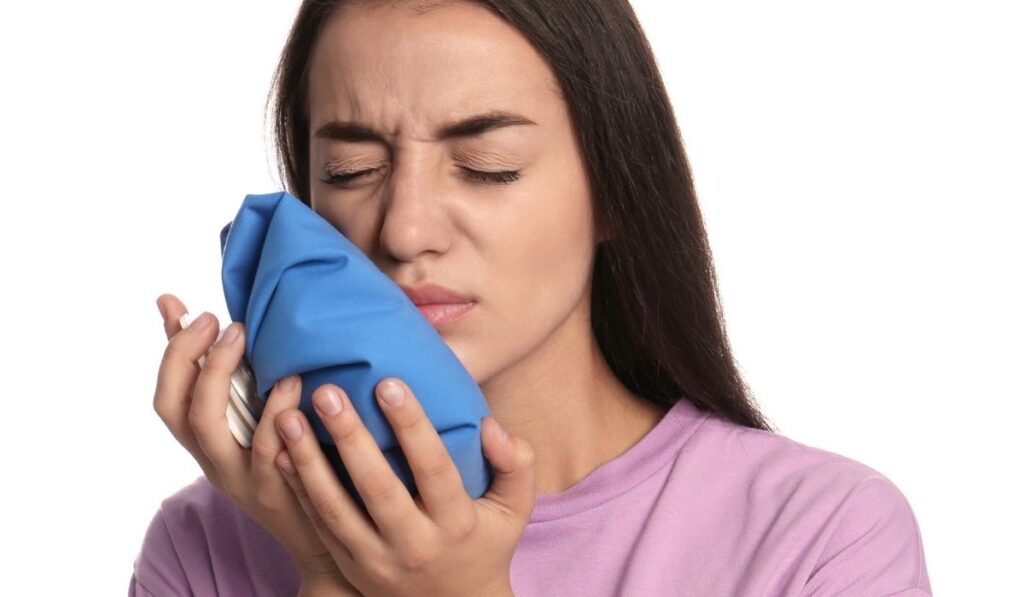Getting your braces taken off is an exciting step after months or years of having them on. Finally, you get to enjoy your new and improved smile! However, getting your braces off typically means starting to wear a retainer or aligner, which can be somewhat uncomfortable at the start. But should you feel any pain from a retainer?
In general, your teeth shouldn’t hurt while wearing a retainer or aligner. The new device may feel foreign or uncomfortable at first, but any painful symptoms that appear should subside over a few days. Be sure to contact your orthodontist If you experience pain for longer than a week.
Although retainers and aligners can be uncomfortable, they’re necessary for retaining that healthy and happy smile that you worked so hard to achieve with braces. Here’s why you might be experiencing pain and what you can do about it.
Should Your Teeth Hurt While Wearing a Retainer?

Although pain is pretty subjective, your teeth shouldn’t hurt while wearing a retainer. This doesn’t mean a retainer won’t feel odd or a bit uncomfortable at first. You may experience discomfort or pain in the beginning simply because your mouth isn’t used to the retainer being there.
Your retainer ensures your teeth aren’t moving around by applying pressure, which can cause slight pain. The discomfort should subside over time as long as your retainer is fitted correctly and in good condition.
It’s best to make an appointment with your dentist if you’re experiencing pain or discomfort for more than a week. Be sure to contact your dental professional if you’re experiencing sharp, stabbing, or severe pains as well.
Your dental professional or orthodontist will check to make sure your retainer is functioning correctly. They may make a few minor adjustments to help alleviate any symptoms.
Why Does Your Retainer Hurt While Wearing It?
Initial discomfort and pain are common symptoms when it comes to retainers. Here are some of the leading causes of these symptoms.
An Unfamiliar Object in Your Mouth
A new retainer or aligner will probably feel a little strange at first. This discomfort is a shared experience and isn’t anything to worry about.
However, these dental products can still irritate the inside of your mouth, your gums, and your lips. The irritation can lead to temporary soreness that typically subsides after a few weeks.
Visit your dentist if symptoms don’t improve after 7-10 days so that they can check on the fit of your retainer and make sure it’s correct.
Your Teeth Are Being Moved
You may be given a new aligner or retainer every one or two weeks at the beginning of your treatment program. Every new set of retainers or aligners will be molded in a slightly different way. This is so they can apply the right amount of pressure to realign your teeth.
The first 3-5 days of wearing a new retainer will typically cause discomfort. Over time, your teeth will settle into their new positions, and the pain should subside. However, the process may start over when you receive your new set of retainers or aligners.
Your Teeth Have Moved
Teeth movement can cause you to feel tightness or pain when wearing a retainer. If you don’t consistently wear your retainer or aligner, your teeth will move out of position.
This will cause the dental tool to feel tighter and more painful when you wear it again. That’s why it’s crucial you only remove your aligner for eating and cleaning throughout the treatment process.
You may need to give your new retainer some time for the discomfort to subside. The initial pain and sensitivity should go away after a few days of continuous use. Be sure to contact your dental professional if you’re still experiencing discomfort.
Sharp Pains
You shouldn’t feel severe, sharp, stabbing, or consistent pain with retainers or alignments. You may need a slight adjustment, or it could be an unrelated issue.
Contact your dental professional immediately if you’re experiencing these types of pain. It’s always easier to prevent a problem rather than fix one.
How to Make Retainers More Comfortable
Although the pain from a new retainer or aligner is temporary, it can cause a significant disturbance in your life. Thankfully, there are ways you can make these dental appliances more comfortable.
Always check with your dentist to see which of these methods is best and safest for you.
Wear Them as Directed
The most common reason for retainer pain is not wearing them as your orthodontist prescribed. Even going a few days without your retainer or aligner can cause your teeth to shift.
This causes the dental appliance to feel more tight and uncomfortable when you wear it again. Wear your retainer as prescribed to prevent pain and discomfort.
Use Over-the-Counter Painkillers
It can take some time for you to get used to a new retainer or aligner. Well-fitting retainers shouldn’t hurt after a few days. Think of it like breaking in a new pair of shoes. It takes time for them to become comfortable, right?
You can take over-the-counter pain medications if you’re experiencing slight discomfort and sensitivity. Consider medications such ibuprofen, Motrin, or Advil (on Amazon).
These products shouldn’t be used as a long-term solution, but they can ease pain during the first few days.
Use Dental Wax or Bonjela Gel
Applying Bonjela gel (on Amazon) or dental wax to affected areas can ease painful symptoms. These products can help cushion your gums from the initial rubbing and irritation caused by retainers.
Eat Soft and Cold Foods
If your retainer or aligner is causing you discomfort, stick to soft and cold foods. These foods are easier to process and break down. The cold temperatures can also help alleviate any soreness, irritation, or swelling. Foods like ice cream, frozen yogurt, smoothies, or even chilled soups can work wonders.
Use a Salt Water Rinse
You can alleviate retainer pain, swelling, and bacteria with a saltwater rinse. Saltwater is a natural antiseptic and can help heal any tiny cuts or scratches. Saltwater can also help remove excess food debris stuck between your teeth.
Stir half a teaspoon of salt into a glass of warm water to make a saltwater rinse. Swish the solution in your mouth for up to 30 seconds. Be sure not to swallow this solution.
Use a Cold Compress

Using a cold compress may ease pain and swelling while your mouth adjusts to the new retainer. You can use a cold compress by applying a bag of ice wrapped in a cloth or an ice pack to the painful location.
This method helps constrict the blood vessels in the affected spot, reducing discomfort and swelling in the process.
Be sure to apply the cold compress to the affected area for no more than 20 minutes every few hours to ease the pain.
When to Call Your Orthodontist
Retainer and aligner pain is typically temporary. If you aren’t wearing your retainer correctly, it can feel tight and cause sensitivity. Your retainer can also change over time and get dirty, resulting in oral issues.
If you’re still experiencing discomfort after a week, you should contact your orthodontist or dental professional. From there, your dental professional will develop a treatment plan to address the issue and alleviate any symptoms.


